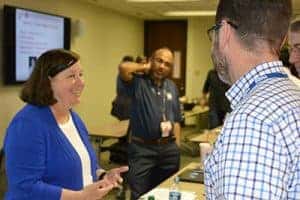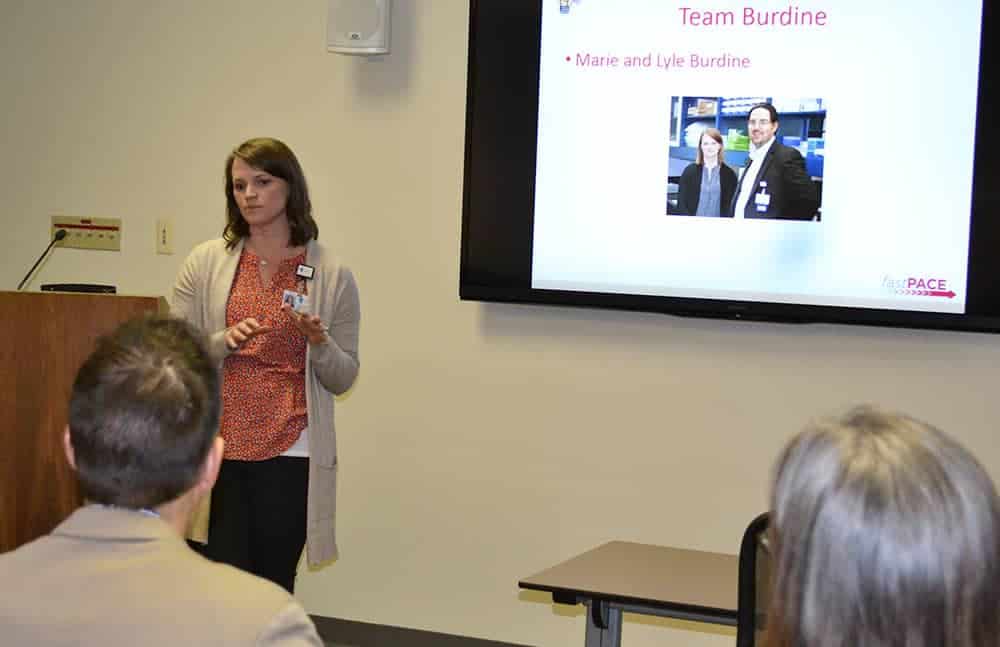BioVentures fastPace Course Helps Researchers Grasp Business Basics
| May 15, 2018 | Even a classroom full of experienced researchers with Ph.D. and medical degrees still found useful things to learn about business during the fastPace course organized by BioVentures.

Nancy Gray, Ph.D., left, and Hari Eswaran, Ph.D., center, visit with some of the judges and teams during a break in the last class session. Gray and Eswaran both were instructors in the fastPace course.
“We enrolled in the class because we thought we had a good idea, but we didn’t really know how to take it to the next step,” said Marie Burdine, Ph.D. “We didn’t know the channels to take, what the patent process was like or if this was even a good idea. That’s why we took the course, to get more information about the process. We learned how to do market research and got great feedback on how to target more people to generate more revenue.”
Burdine is an assistant professor in the Division of Surgical Research in the UAMS College of Medicine’s Department of Surgery.
FastPace was developed by FastForward Medical Innovations at the University of Michigan and is designed for the busy medical academician with an early-stage project. It blends in-person and online education to help faculty researchers and clinicians learn the basic components of biomedical commercialization and prepare a successful business case for funding and developing partnerships.
FastPace is one of the newest courses offered by BioVentures and the researchers and clinicians who enrolled was the first class at UAMS to complete the course. Course sessions for the four-week course in biomedical commercialization started in late March.
Burdine teamed up with her husband, Lyle Burdine, M.D., an assistant professor in the College of Medicine’s Department of Surgery and a transplant surgeon, to develop a nanoparticle for treating clostridium difficile, a bacterial infection of the colon commonly referred to as C. diff. The nanoparticle binds to toxins caused by C. diff and removes them from the colon.
On April 27, there were 10 teams that finished the fastPace course. Five were in the device/diagnostic track, three were in the therapeutics track and two were in the health information technology track. Seven teams were from the College of Medicine, two from hospital staff and one from University of Arkansas, Little Rock. Nancy Gray, Ph.D., head of BioVentures, served as site director and lead instructor for fastPace. Curtis Lowery, M.D., Nancy Rusch, Ph.D., and Hari Eswaran, Ph.D., served as co-instructors.
Lowery chairs the College of Medicine Department of Obstetrics and Gynecology, and Eswaran is a professor in the same department. Rusch chairs the College of Medicine Department of Pharmacology and Toxicology and leads the educational efforts of the UAMS Translational Research Institute.
“The fastPace course was designed to teach members of the biomedical community how to develop a business case to secure funding, determine commercial viability of an innovation, build a business network and instill confidence in making a business presentation,” Gray said. I think it achieved all those things and a fuller understanding of what’s needed to take something from the lab to the market.”
Robert Griffin, Ph.D., professor in the College of Medicine’s Department of Radiation Oncology, was part of the Wild Parsnip team with Samir Jenkins, Ph.D., a postdoctoral fellow in the same department. The team’s product is a cancer therapy based on one of the chemicals in wild parsnip that is activated by ultraviolet light to be toxic to cancer cells. The treatment is designed for patients with cancer that is recurrent, in an anatomical position that’s not conducive to surgery or where a residual tumor is still present in the patient.
“I have a little bit of background working with other small companies, but fastPace is more in-depth and focused,” Griffin said. “We were pushed to get a lot of stuff done in a month. It usually takes a year to do this sort of thing. The most valuable part of the course was the understanding we gained about the different stakeholders that you have to convince and what is the value at each stage of development. With cancer, you think of the patient first, but there are a lot of steps before that. That was useful.”

